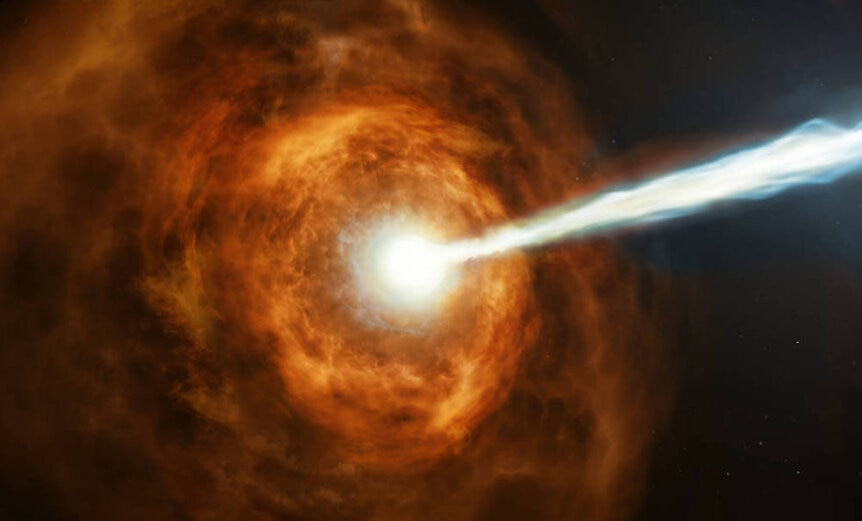Create a free profile to get unlimited access to exclusive videos, sweepstakes, and more!
Gamma radiation and superpowers: The science behind She-Hulk
Like Bruce Banner, Jennifer Walters gains the ability to transform into a Hulk after exposure to gamma radiation. We have a few objections...

We all know that Bruce Banner became the Incredible Hulk when he was exposed to gamma radiation. Now, with the release of She-Hulk: Attorney at Law, we’ve got our first look at another member of the Hulk family in the MCU, and things are a little different.
Instead of direct exposure to unfettered gamma radiation, Jennifer Walters hulks out after becoming she's contaminated with some of Bruce Banner's blood. In the comics, the contamination is the result of an emergency blood transfusion. In the show, it happens differently but the result is the same, Walters gains a version of her cousin Bruce’s powers. Having seen the show and the movies, or having read the comics, one might assume that gamma radiation is a non-stop ticket to becoming a super, but the real-life scientific evidence doesn’t quite support that argument.
EXHIBIT A: WHAT IS GAMMA RADIATION AND WHERE DOES IT COME FROM?
Radiation gets a bad rap. In the popular consciousness, we associate it with nuclear disasters and toxic spills, but it’s an ordinary part of living in the universe. In simple terms, radiation is just the movement of energy through space. Everything is radioactive. You, your cat, the bowl of leftovers you’re eating for breakfast — and that’s even before you put it in the microwave, which utilizes yet another form of radiation — we’re living in a well-mixed soup of radiation all the time. Most of that radiation is more or less harmless. It has been around longer than we have, and we’ve evolved to live inside it.
When we’re thinking about dangerous radiation what we’re really thinking about is specific types of radiation, the kinds which we don’t encounter very often and which we haven’t evolved to deal with very well. Those tend to live at higher frequencies with shorter wavelengths.
You can visualize radiation as a scale. At one end you have low frequency, large wavelength radiation. That’s where you find radio waves, infrared, and visible light. Moving toward the other end of the spectrum you get ultraviolet, X-rays, and finally gamma. Ultraviolet is moderately dangerous over long enough time scales. Anyone who’s forgotten to reapply sunscreen at the beach has felt the sting of too much UV exposure. Still, UV radiation can’t compare to the energies at the far end of the scale.
The further you get along the electromagnetic spectrum; the more energy particles are carrying. Once you hit X-ray, they’re moving fast enough to knock electrons off of your own atoms. For that reason, we call X-ray and gamma radiation ionizing radiation. Controlled exposure for brief periods and not very often isn’t very dangerous. That’s why it isn’t a concern for you to get X-rays of your teeth when you go to the dentist, but the technician wears an iron apron and stands behind a wall. Getting prolonged exposure to your entire body, or even brief exposure to a very strong source is a fundamentally bad idea.
On Earth, gamma radiation is produced inside the nuclei of radioisotopes like uranium, radium, and thorium. It’s also produced in high-energy cosmic objects elsewhere in the universe, like supernovae, pulsars, and black holes in the form of gamma ray bursts. They’re powerful enough that if one were to happen relatively close by and hit the Earth, it could trigger a mass extinction event by stripping away our planet’s ozone layer. Basically, gamma radiation isn’t something to mess around with.
EXHIBIT B: WHAT WOULD REALLY HAPPEN IF YOU WERE EXPOSED?
As with most forms of radiation, this is all a matter of degree. People do regularly get exposed to gamma radiation, and sometimes on purpose. Gamma radiation is commonly used in cancer treatments precisely because of how good it is at destroying tissues.
When powerful ionizing radiation comes into contact with cancer cells, the energy causes the breakdown of DNA in the nucleus, causing the cells to stop growing or replicating. Ultimately, those cells die. These treatments are carefully controlled such that they impact only the target region, slowing down and hopefully stopping cancer in its tracks. That said, nearby tissues can be impacted, and doctors work tirelessly to minimize those effects.
What happens to a person after exposure depends on what part of the body has been exposed, how strong the radiation is, and how long they remain in contact with it. If the dose is high enough, you’ll quickly lose your hair, your lymphocytes will die making you more susceptible to secondary infection, damage to the heart and wider circulatory system will occur, and you’d pretty quickly be incapacitated. Damage to the heart and nervous system can cause heart failure or seizures and a person can die within days or weeks, even with medical treatment.
It's worth noting that in some versions of the Hulk story, Bruce Banner was exposed to a relatively manageable dose of gamma radiation, based both on the amount of total radiation and the position of his body. It’s possible, depending on the specific factors of each telling, that he might have survived without many detrimental effects. Of course, Jennifer Walters wasn’t exposed directly, she got her gamma exposure secondarily from Bruce’s blood…
EXHIBIT C: TRANSFERING GAMMA RADIATION VIA BLOOD?
This is where the logic of the Hulk and She-Hulk really breaks down. It’s true that an irradiated person can sometimes cause secondary exposure to someone else. A person who has been contaminated can pass on that contamination through contact with body fluids, including blood. However, by the time Jennifer enters the picture, Bruce has been the Hulk for years. Any radiation which might have persisted inside his body would long since have faded away.
More importantly, only certain types of radiation remain in a person’s body for extended periods. Notably, gamma radiation isn’t one of them. It’s energetic enough that it passes through your body at the speed of light and continues onward. In a hospital setting, they capture that radiation on the other side of your body with specialized shields.
Bruce wouldn’t have been able to pass on gamma radiation to anyone else even moments after his initial exposure, let alone years down the line. There’s no danger in getting exposed to the blood of a person who has been blasted by gamma radiation, at least not from the radiation itself. A blood transfusion might be a risky endeavor, especially if it’s still early days when their immune cells have been decimated. In that case, however, they’re more likely to be in need of a transfusion than giving one.
We’re left to make one of two conclusions. Either gamma radiation works entirely differently in the Marvel universe, or it is a name given to some other substance that isn’t really radiation at all. We’d like to get Jennifer and Bruce under oath to find out how she really got her powers, because the story as it is presented doesn’t hold up under scrutiny. We rest our case.




























